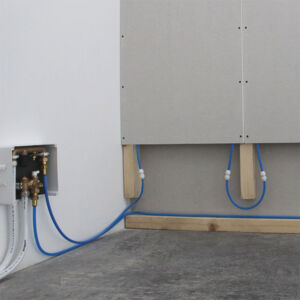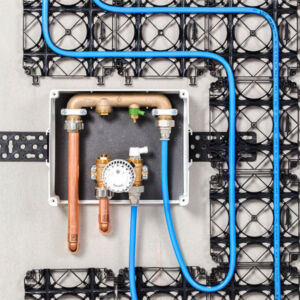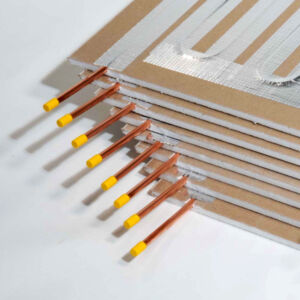Retrofitting Wall Heating in Older Buildings
Some walls make you think warm thoughts. Walls with wall heating warm rooms
Wall heating is also easy to retrofit in old buildings. Both internal and external walls can be used. Wall surface heating is always an interesting alternative when the floor surface is to be retained, the ceiling height or special features of the ceiling make ceiling heating impractical, or the walls have a moisture problem. In terms of energy, wall heating is in between ceiling and underfloor heating. Approximately 70% of the heat output is radiant heat.
This results in rapid heat-up, low dust turbulence and all the other benefits traditionally associated with surface heating. Wall cooling is also possible. Wall switches, cabling and other wall fixings should be taken into account when planning the installation. However, by adapting the installation form (plaster variant) or using blind elements (dry construction), wall installations are generally not a problem. In order not to impair the performance of the wall heating, the thermally activated wall should not be blocked by large furniture or similar items.
Wall heating in old buildings can also be used to supplement underfloor or ceiling heating to provide extra heat in rooms with high ceilings and poor insulation. Installation in sloping roofs is also possible.
What makes FLEXIRO wall heating so attractive for retrofitting?
FLEXIRO panel heating systems use thin 10mm diameter heating pipes with small bending radii. This results in tight heating loops and therefore particularly even heating of the wall surface. Whether you choose the drywall system, the plaster version or the high performance elements with copper pipe: FLEXIRO systems achieve an above-average proportion of radiant heat.
The thin pipes also have the advantage that the wall heating can be retrofitted without major intervention in the building fabric. The plaster wall heating has an installation height of 13 mm. It can be installed without noticeably reducing the size of the room. Although the drywall system with integrated heating pipe has a greater installation height because it is installed on wooden battens, it can also be insulated, which can be an advantage when installed on external walls.
The small diameter of the heating pipes means that the length of individual heating circuits is limited to 30 metres. For this reason, wall heating sets are available up to a maximum of 10 m². For larger rooms, several sets can be combined and each connected to the heating system via an RTL box. Connection to a heating circuit manifold is also possible. For this we prepare individual quotations without a control box.
In this way, wall heating can be retrofitted room by room. The simplicity of the installation also makes it possible to do the installation yourself. At a later date, the entire heating system can be converted to a heat pump or regenerative heat sources to further optimise energy consumption.
info
Thermal comfort
Compared to conventional heating systems, wall heating requires approximately 1-2 degrees less room air temperature to create a feeling of thermal comfort. The reasons for this are the warmth of the surfaces surrounding the room, the reduced air circulation and the radiant heat from a vertical surface, which is perceived as pleasant.
These effects contribute to a high level of thermal comfort. At the same time, energy costs can be further reduced. The use of natural plaster materials such as clay also has a positive effect on the indoor climate through better regulation of humidity.
Plastering method, drywall or copper pipe?
Plastering methods
add_circle
Clay, lime or gypsum plasters can be used. This allows the specific properties of the plaster to be exploited. High heat output. Low construction height. Custom installation pattern possible.
highlight_keyboard_focus
Plastering brings moisture into the room. It delays the finishing of the wall surface.
Dry Construction
add_circle
The wall surface can be produced and finished quickly. Prefabricated components. Standard dimensions make planning easier. Insulation possible for external walls.
highlight_keyboard_focus
Greater installation height when mounted on wooden slats. Slightly lower heat output compared to the plaster version.
Copper pipe
add_circle
More heating power, fewer heating elements may be required for the size of the room. Easy design and quick installation of pre-fabricated heating elements thanks to standard dimensions. Insulation of external walls possible.
highlight_keyboard_focus
Higher initial cost. Available for drywall construction only.
Wall heating kits
forum
For the FLEXIRO wall heating dry construction, a standard gypsum plasterboard 12 mm thick is used. For damp rooms, dry construction recommends an impregnated gypsum plasterboard GKBI. Please ask for a customised offer.
Yes, the FLEXIRO wall heating can be mounted on an exterior wall. However, the exterior wall should have a maximum U-value of 0.30 W/m2K. If insulation is installed behind the wall heating to minimise heat loss to the outside, a building physics check of the construction may be required to prevent condensation in the wall when the wall heating is not in operation. During operating, the wall heating will dry-heat the affected wall rather than causing moisture damage to the construction.
After installing the drywall panels, you can visualise the arrangement of the heating pipes in heating mode with a thermal imaging camera. The pipes have a distance of 100 mm. In this way, pictures can also be hung later. Alternatively, if the walls are not tiled, you can spray them slightly damp when the heating is on. Where a heating pipe runs, the moisture will dry off more quickly.
Such a combination is possible as long as the max. number of 4 heating circuits is not exceeded. In addition, it must be ensured that the differences in length between the individual connections do not exceed 15%. Otherwise there could be problems with the hydraulics. For combinations of wall and underfloor heating systems within the scope of these guidelines, we will be happy to submit an individual offer.



